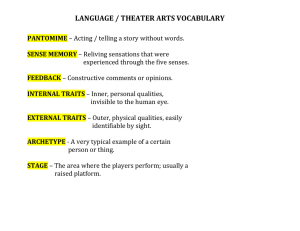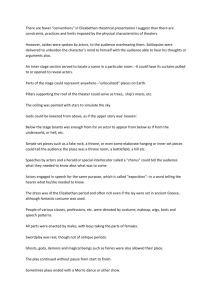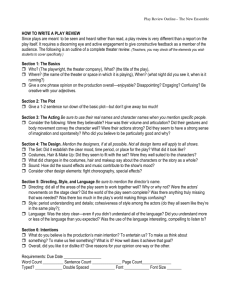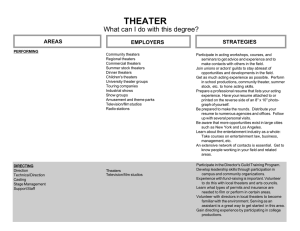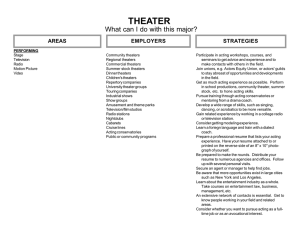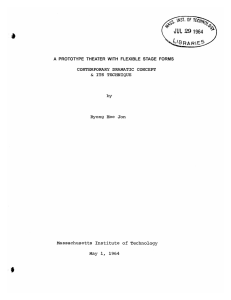Theater Space - Cloudfront.net
advertisement
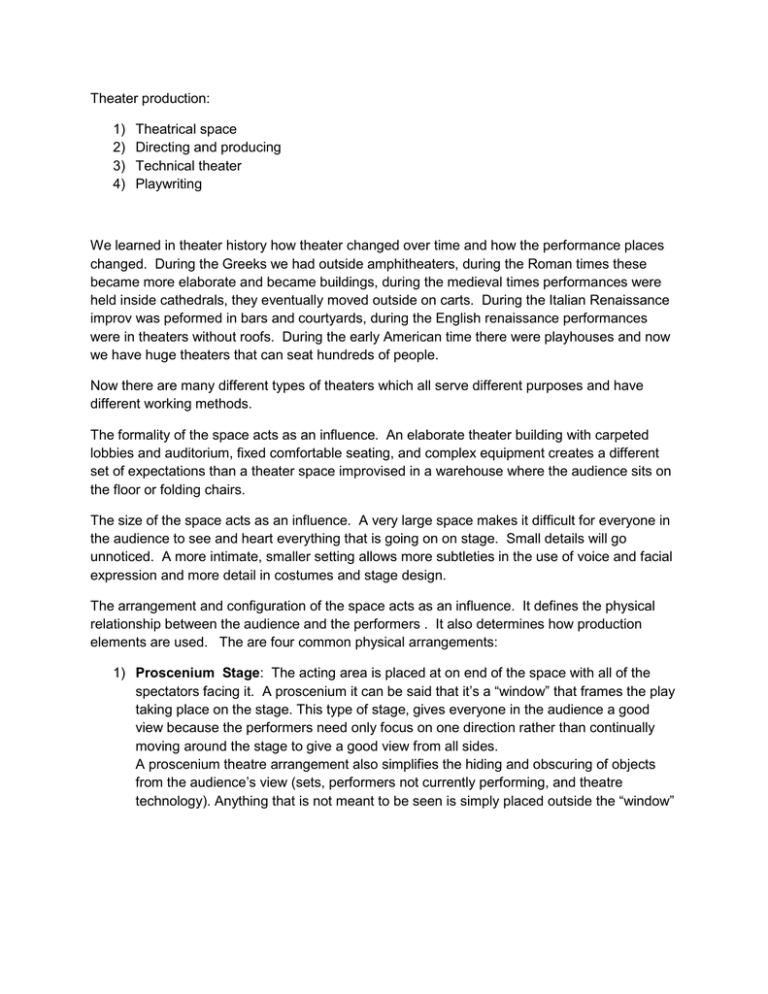
Theater production: 1) 2) 3) 4) Theatrical space Directing and producing Technical theater Playwriting We learned in theater history how theater changed over time and how the performance places changed. During the Greeks we had outside amphitheaters, during the Roman times these became more elaborate and became buildings, during the medieval times performances were held inside cathedrals, they eventually moved outside on carts. During the Italian Renaissance improv was peformed in bars and courtyards, during the English renaissance performances were in theaters without roofs. During the early American time there were playhouses and now we have huge theaters that can seat hundreds of people. Now there are many different types of theaters which all serve different purposes and have different working methods. The formality of the space acts as an influence. An elaborate theater building with carpeted lobbies and auditorium, fixed comfortable seating, and complex equipment creates a different set of expectations than a theater space improvised in a warehouse where the audience sits on the floor or folding chairs. The size of the space acts as an influence. A very large space makes it difficult for everyone in the audience to see and heart everything that is going on on stage. Small details will go unnoticed. A more intimate, smaller setting allows more subtleties in the use of voice and facial expression and more detail in costumes and stage design. The arrangement and configuration of the space acts as an influence. It defines the physical relationship between the audience and the performers . It also determines how production elements are used. The are four common physical arrangements: 1) Proscenium Stage: The acting area is placed at on end of the space with all of the spectators facing it. A proscenium it can be said that it’s a “window” that frames the play taking place on the stage. This type of stage, gives everyone in the audience a good view because the performers need only focus on one direction rather than continually moving around the stage to give a good view from all sides. A proscenium theatre arrangement also simplifies the hiding and obscuring of objects from the audience’s view (sets, performers not currently performing, and theatre technology). Anything that is not meant to be seen is simply placed outside the “window” created by the proscenium arch, either in the wings or in the fly space above the stage. 2) Thrust Stage: The acting area is surounded on two or three sides by the audience. The Fourth side serves as the background. Often the playing area is of square or rectangular shape, usually raised and surrounded by raked seating. This configuration is more intimate than the proscenium stage because the audience is closer to the actors. Because the set is seen from multiple angles the stage design has to be kept relativle small which discourages realistic backdrops and scenery. Tall units must be kept to the back of the stage. 3) Arena Stage: The acting are is completely surrounded by the audience on all sides. The stage area is also often raised to improve sightlines. This looks like a boxing ring. The seating is usually a stepped arrangement. Because the arena theater provides a three dimensional playing area, the actors, director and technical directors have to concern themselves much more with site lines. There is no curtain so all changes are made either in full view of the audience or in semi darkness. Many permanent stages like these have passageways running under the seating and opening onto the acting area. There is nothing hidden on stage. Actors can move more freely however seeing they always face the audience no matter what direction they are faced. Most arena’s are small and intimate. 4) Flexible Space: perhaps a box theater or found space. Shakespear in the park down town is a flexible space. Flexible spaces are often found spaces, perhaps outside in a dea end allyway, or on a plaza, in a park. They can be inside in an old warehouse or an entry way or lobby to bigger buildings. It is any space used as a performance space which is not originally created to be one. The audience and the actors may be intermingled, or the place of performance may shift. A black box theater is a bare room with black walls. The Warehouse theater is one of these. It is most often used for productions with limited or special appeal. Besides the stage and audience seating there are auxiliary spaces found; the lobby, the restrooms, the corridors, exits, refreshment stands. Other spaces are used for theater personnel such as the box office, the scene shop the property room, the costume shop and costume storage, the light shop and lighting storage, the control booths for lighting and sound boards, rehearsal rooms, dressing rooms, a green room and business offices.
